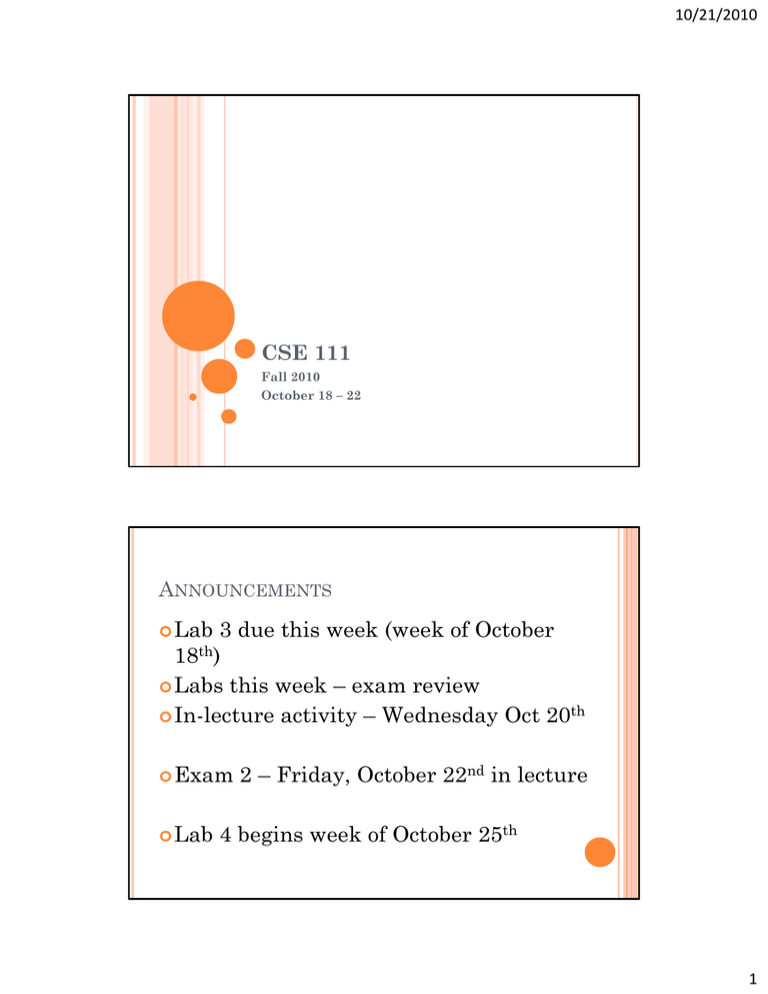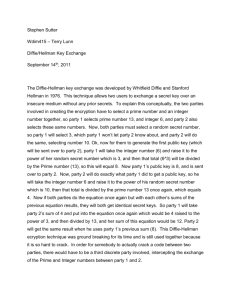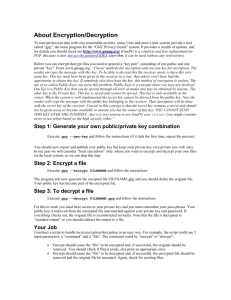Lab 3 due this week (week of October 18 )
advertisement

10/21/2010 CSE 111 Fall 2010 October 18 – 22 ANNOUNCEMENTS Lab 3 18th) due this week (week of October Labs this week – exam review In-lecture activity – Wednesday Oct 20th Exam Lab 2 – Friday, October 22nd in lecture 4 begins week of October 25th 1 10/21/2010 SECURITY IN OPERATING SYSTEMS SECURITY IN OPERATING SYSTEMS 2 10/21/2010 SECURITY ON A NETWORK HOW CAN COMPUTERS (AND USERS) PROTECT THEMSELVES? 3 10/21/2010 PRACTICE PROBLEMS FOR EXAM 2 Questions at the end of Chapter 2 (pages 113-117) 4 5 7 9 11 12 13 14 15 16 17 18 20 21 22 23 26 27 PRACTICE PROBLEMS FOR EXAM 2 Questions at the end of Chapter 3 (pgs 146-149) 1 3 5 7 8 10 11 18 19 29 31 32 45 49 50 4 10/21/2010 PRACTICE PROBLEMS FOR EXAM 2 Questions at the end of Chapter 4 (pgs 197-199) 1 2 3 4 5 11 17 18 19 20 21 24 25 34 35 37 IN-LECTURE ACTIVITY #4 Encryption 5 10/21/2010 VOLUNTEERS (NEED 6) Volunteers 1-5: Pick a number with 1 or 2 digits and write it on the piece of paper. (Will also need to do some addition in a moment.) Volunteer 6: Pick a 3-digit number and write it on the piece of paper. VOLUNTEERS 1-5 When you receive the pad of paper, add the number you picked to the number on the pad. Write the answer on the next page in the pad. Rip off the top page (it’s yours to keep as a souvenir). 6 10/21/2010 COMPUTE THE AVERAGE Pad of paper comes back to Adrienne DID WE COMPUTE THE CORRECT AVERAGE? Figure it out 7 10/21/2010 SENDING “SECRET” INFORMATION Tell someone the “secret number” To send “secret message”, take the message and add the “secret number” to it To decode, subtract the “secret number” from the message you receive ANOTHER “PUBLIC SECRET” EXAMPLE Volunteer Pick 1: a number > 50 and < 1000 Now pick 10 other numbers that will add up to our secret number 8 10/21/2010 PUT THE NUMBERS ON THIS GRAPH BUT WE WILL ACTUALLY SEND THIS 9 10/21/2010 OUR RECEIVER WILL DECODE USING… WHY DO WE ONLY NEED THREE? 10 10/21/2010 MORE COMPLEX EXAMPLE PRIVATE GRAPH 11 10/21/2010 SO WHAT IS THE MESSAGE WE ARE SENDING? PROBLEM No matter how complex the graph, we still could break it. So, the key to public key cryptosystems is to create keys that are hard to “crack” 12 10/21/2010 PUBLIC KEY ENCRYPTION (RSA) My children want to send a message to me Step1: They write out the message Step 2: Break message into chunks of 4 characters Step 3: Convert the chunks to numbers Step 4: Use Mom’s public key to encrypt message Step 5: Send message to Mom ENCRYPTION Mom gets message and uses private key to decrypt message and read it. To respond, Mom does same steps, but uses the kid’s public key to encrypt. The kids use their private key to decrypt. Neither party knows the other’s private key, only their public keys. 13 10/21/2010 MORE DETAILS – THE MATH Choose two prime numbers p & q p & q have at least 150 digits each Compute n = pq Compute k = (p-1) * (q-1) Find e: e is a prime number between 1 & k and is relatively prime to k. Relatively prime means that the greatest common divisor between e & k is 1 MORE DETAILS – THE MATH Then, we solve the following equation for d & v (d*e) – (v*k) = 1 We keep d, e, and n Public key: e & n Private key: d & n 14 10/21/2010 CONVERTING MESSAGE To encrypt message: (Message as number)e mod n Send result When receiver gets message, decrypt using: (Received message)d mod n HOW IS IT SECURE? Leaving some of the math details out, in order to get the private key (d), we would need to be able to factor n into p & q. n is a 300-digit number 15 10/21/2010 CAN WE DO IT? Latest data I could find: We can factor a 232-digit number into its prime factors But It took 2 years And hundreds of machines 16







